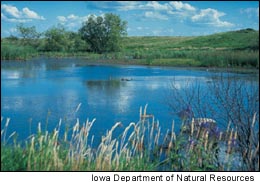|
Restoration to "pre-man" : Bringing back
Iowa's prairie potholes
Thursday, June 06, 2002
Iowa's prairie pothole region was defined following the last glacial
age some 12,000 to 14,000 years ago.
Left in the path of retreating glaciers were a multitude of potholes and lakes scattered throughout an undulating terrain of fertile soils, all of which were exposed to a climate of favorable rainfall. Prairies flourished, wildlife was abundant. Not surprisingly, these conditions would draw European settlers west, followed by the inevitable: development. Development has taken a heavy toll on Iowa's wildlife habitat — the state has lost 98 percent of its wetlands and more than 99 percent of its prairies since settlement. Tucked away in the northwest corner of the state's prairie pothole region, the 62,300-acre Iowa Great Lakes watershed contains the greatest concentration of wetlands remaining in the state. Approximately 21,900 acres of existing or restorable pothole wetlands and deep-water lakes lie in this special place, including Iowa's two largest natural lakes: 5,684-acre Spirit Lake and 3,847-acre West Okoboji. This area relies heavily on tourism for its economic base (more than $60 million annually), and as one might guess, development and recreational pressures on remaining habitat abound. In 1993, the Iowa Great Lakes partnership formed to protect and restore the watershed's habitats. It devised a multiphase plan to guide and focus its efforts. To date, three large-scale projects have been completed involving $1.9 million in North American Wetlands Conservation Act grants and $2.5 million in partner funding to protect and restore 3,290 acres of wetlands and associated uplands. Partners of numerous smaller projects have added at least 1,500 acres more of protected habitat to the watershed. The acquired lands and restored wetlands and prairies offer a multitude of benefits to waterfowl and wetland-associated wildlife by providing high-quality production, staging, loafing, and feeding areas for both resident and migratory species. Mallards, blue-winged teal, wood ducks, and giant Canada geese are among the many waterfowl species using the project sites, and the project area is at the heart of Iowa's popular Trumpeter Swan Restoration Program. However, more than waterfowl have benefited from this effort. At least 85 nongame bird species have been recorded in the project area, including species of management concern such as the northern harrier, cerulean warbler, and black tern. Recreational use of these areas by hunters, birdwatchers, and environmental educators has increased substantially. The Iowa Department of Natural Resources has nominated several sites within the project area as Bird Conservation Areas. Iowa Audubon is also proposing to list several locations within the project's boundaries as Important Bird Areas. The Iowa Watchable Wildlife Guide notes that the Iowa Great Lakes area provides some of the best birding areas in the state. Local communities recognize the importance of the work being done and offer support because of the benefits accruing to them. Examples include improved surface and groundwater quality and increased tourism, which boosts local economies. Hardly taking a breath, the partnership is developing another project, expanding on the benefits created in the past by bringing back more of Iowa's prairie potholes. Iowa Great Lakes project partners include U.S. Fish and Wildlife Service, Iowa Department of Natural Resources, Environmental Protection Agency, Dickinson Soil and Water Conservation District, Jackson Soil and Water Conservation District, Dickinson County Conservation Board, Ducks Unlimited Inc., Great Lakes Chapter of Ducks Unlimited Inc., Dickinson County Pheasants Forever, Emmet County Pheasants Forever, Northern Iowa Prairie Lakes Audubon Society, Iowa Natural Heritage Foundation, Okoboji Protective Association, Spirit Lake Protective Association, Tommy Thompson, Doug Harr, Dale Lundstrom, Erwin Wackerbarth Jr., and Neil Heiser. Dale Garner and James Zohrer work for the Iowa Department of Natural Resources.
Copyright 2002, Birdscapes: News from International Partnerships
All Rights Reserved
In accordance with Title 17 U.S.C. Section 107, any copyrighted work in this message is distributed under fair use without profit or payment for non-profit research and educational purposes only. [Ref. http://www.law.cornell.edu/uscode/17/107.shtml] |
